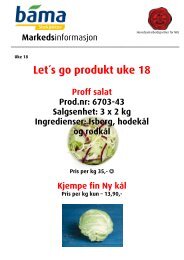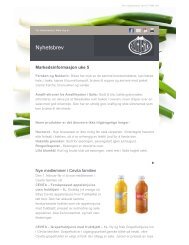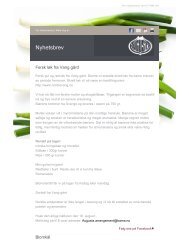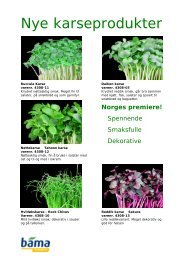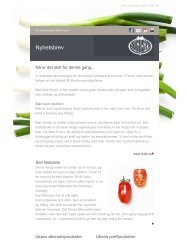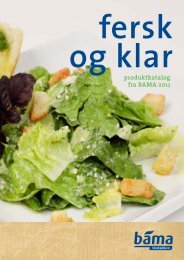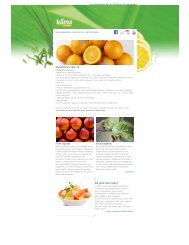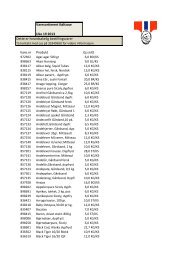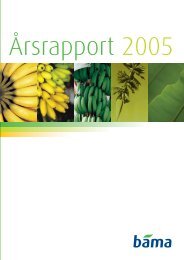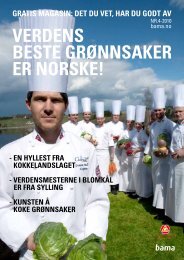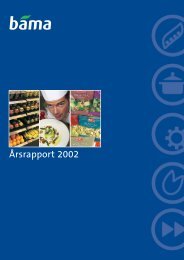BAMA’s corporate social responsibilityTargets for 2010EcuadorContinue permanent followupin Ecuador, now also withregard to the flowers sectorand pineapple producers.Project Building Education, ajoint project between the localunion, the authorities, Doleand BAMA.Costa RicaExtend work to cover theentire banana industry in thearea, including unions andthe authorities in addition tothe Norwegian Confederationof Trade Unions (LO), theFederation of NorwegianCommercial and ServiceEnterprises (HSH) and theNorwegian Ministry of ForeignAffairs (UD) as part of thefollow-up of the Memorandumof Understanding whichBAMA entered into with UDin 2009. Tesco is also activelyparticipating.Strengthen collaboration withBananalink.South AfricaContinue project in SouthAfrica focusing on boostingemployee representativeinvolvement in projectimplementation.Corporate social responsibility in practicestatusCommercial pineapple projects have been trialled. No flowers-relatedprojects were initiated during 2010.New school room in Rio Viejo opened in 2010. New funds granted forcommunity development in accordance with the same model.Several meetings were held with the CSR Director and Corbana (theCosta Rican Banana Corporation). A major conference was held andattended by participants from the entire industry in Costa Rica, theNorwegian ambassador along with representatives from BAMA, LOand HSH.Project application submitted by LO and HSH to UD for project supportto reinforce three-party collaboration in Costa Rica in accordance withBAMA’s model. The project runs until 2013.Economic support from Parat in BAMA for training the Cosiba CostaRica union’s employee representatives.Effective and direct contact several times a year.Greater involvement on the part of employee representatives hasstrengthened collaboration with the union, although this work hasbecome more demanding as a result of the latter’s incorporation intothe national union.CO 2emissions, where the greatest improvements came from energysavings and waste management. Emissions from internally ownedtransport and fossil fuels increased by 6.8 per cent. The results areused as a basis for improvement measures. The target for 2011 is areduction in CO 2emissions of 5 per cent. BAMA is also participatingin a joint project intended to establish a separate standard for carbonfootprints – i.e. to map a product’s total environmental impactfrom production to consumption. BAMA aims to identify the carbonfootprint for 80 per cent of its total sales volume by 2015.From road to rail. An important environmental target is to move anincreasing percentage of transport activities to the railways – bothwithin Norway and on the continent. BAMA’s transport strategytherefore has a clear railway focus. One specific target is to ensurethat half of all incoming goods are transported by rail by 2020.Action plan for packaging. In 2009 BAMA adopted a dedicatedaction plan for packaging. From an overall perspective packaging hasa positive environmental impact on our business in that it reduceswastage along the value chain – as it means fewer products have tobe thrown away. The action plan aims to develop packaging solutionsthat provide optimal protection for goods during transport.Eco-Lighthouse. All the operating units in the HoReCa and grocerybusiness areas are due to be certified as Eco-Lighthouses during 2011.The Eco-Lighthouse scheme is a Norwegian certification programmethat helps businesses to operate in an environmentally friendlymanner and establish a clear environmental profile. The businessesundergo an environmental analysis, and if they satisfy a set of definedindustry requirements, they are accorded Eco-Lighthouse status. ForBAMA this involves a particular focus on energy, transport, purchasingand waste management. A total of 12 departments were certifiedas Eco-Lighthouses in 2010, and the remaining departments will becertified in 2011.Quality and food safety. Guaranteeing high product quality not onlysecures a competitive advantage – it is also part of our corporate socialresponsibility remit. Consumers must have complete confidence thatgoods delivered by BAMA are safe to eat at all times. We continuedto make quality improvements in 2010. The Group slightly exceededpermitted pesticide levels in its products on a few occasions; however,none of these incidents posed a threat to health. The average internalclaims cost decreased further, from 0.66 per cent to 0.50 per cent.12 00010 0008 0006 0004 0002 000Emission sourcesFlightsElectricityVehicle transportand fossil fuelTotal CO 2emissions are down by 4.4 per cent, wherethe largest decrease is attributable to a reductionin waste.Pesticide residuesClaimsTotalWaste• 2009 • 20107550352315743502006 2007 2008 2009 2010• BAMA • IndustryPesticide residues were found to exceed permittedthresholds in five products. None of the incidentsposed a threat to health.GuatemalaFollow-up of ongoing projectin Guatemala.Israel/PalestineStrengthen collaborationbetween producers/exportersin Israel and Palestine.NorwayFollow-up of Norwegianproducers in collaborationwith Gartnerhallen regardingsocial dumping.Need for stronger management of project in Guatemala. Furthermeasures and stricter follow-up to be implemented in 2011.Follow-up of producer, check validity of claims of child labour inPalestine. Promotion of market orientation towards the West withregard to export business.Collaboration with the United Federation of Trade Unions in LO inrelation to the agriculture sector. On one occasion supplier purchaseswere suspended until the requisite documentation and clarificationshad been furnished.The introduction of an automatic monitoring system to measure theideal temperature during transport of products from Europe helpedto cut temperature non-compliances by 60 percentage points andsignificantly raise product quality.BAMA has implemented an HACCP system (Hazard Analysis andCritical Control Point) which focuses on food safety and analysis of thevalue chain in relation to critical points. This forms the basis for furtherdevelopment of requirements of suppliers and for systems intendedto secure food safety. BAMA adopts Global GAP and KSL as definedquality standards for primary producers in both Norway and abroad.In addition, the company’s fresh salad production plants are certifiedin accordance with the British Retail Consortium (BRC) standard.In 2010 a small batch of imported lettuce was recalled due tosuspected microbiological contamination.20092008200720060.50%0.66%0.87%0.83%0.96%A focus on preventative measures is helping to cutaverage claims costs.28 BAMA annual report 2010BAMA annual report 2010 29
ama’sculturecorporategovernanceBAMA has constantly striven to cut itssickness absence rate since 2009. Thanksto preventative measures and effectivecommunication, we achieved our best-everresults in 2010.As part of our drive to permanently cut the sicknessabsence rate, we continued our management traininginitiatives in this area in 2010. This involved ongoinghighlighting of issues relating to sickness absence workand preventative measures, and facilitation of betterdialogue between managers and staff.Preventative HSE measures included a deliberate focus oncorrect lifting techniques and employees’ responsibilityfor looking after their own health. The company has alsofocused on encouraging employees signed off as ill to workreduced hours, wherever such is feasible. Experience showsthat employees return to full-time work more quickly – anaim shared by both parties – under such circumstances.Follow-up of sickness absence has now been incorporatedinto managers’ daily routines, resulting in record-lowsickness absence in 2010 of 6 per cent, compared with7.6 per cent in 2009. This extremely pleasing result, whichis attributable to efficient personnel management, hasalso generated significant cost reductions.Inclusive Working Life (IA) business in 2010High sickness absence has also been a problem in the pastat BAMA Industrier AS’s salad factory. However, mapping ofsickness absence together with the adoption of ambitioustargets has made it possible to implement systematic andinclusive measures at all levels in the factory. A consultantfrom the Norwegian Labour and Welfare Service (NAV)assisted in the process, which also involved the HR departmentand the occupational health service. In 2010 the saladfactory was awarded the IA prize from NAV Arbeidsliv inBuskerud for its work in this area with the following citation:“Few businesses focus more strongly on IA; both thecommitment and results are impressive.”Improving health with BAMA PlussPreventative employee-targeted health initiatives haveplayed an important role in keeping sickness absence atgenerally low levels for a number of years. BAMA Pluss isan employee-orientated concept focusing on diet, physicalactivity and mental health. The concept is intended toestablish healthy fundamental attitudes throughout theorganisation. Specific measures implemented include theprovision of a ready supply of fruit, vegetables and waterduring working hours, discounted personal purchases,healthy lunches, annual health checks and facilitation ofparticipation in physical activities.Consistently high levels of job satisfactionSatisfaction surveys are conducted each year throughoutthe organisation. The results reveal high levels of employeesatisfaction. BAMA has a long-standing culture of taking careof its employees. With major ethnic and cultural diversityamong our staff, we are keen to create an inclusive workinglife for everyone. BAMA shall be a safe and attractive workplace.This goal, which requires a mutual focus on respect,trust and dialogue, is embraced by the entire organisation.Effective collaboration with employee representative bodieswill be pivotal for BAMA’s future performance.Sickness absence8.4%Industry7.5% 7.6% 7.9%NorwayIndustry6.8%Norway2009 20106%BAMA <strong>Gruppen</strong> AS is a leading company and a trendsettingsocial player within fresh and freshly processedfruit and vegetables, and flowers in Norway. The companyoperates in a global market, which entails a significantresponsibility in terms of food safety and corporate socialresponsibility. Effective business management shall contributeto increased growth, value creation and a goodreputation.Corporate governanceIn accordance with the Norwegian Limited LiabilityCompanies Act, the company’s board is responsible forensuring that the company’s business and administrationare properly organised. BAMA <strong>Gruppen</strong> is run as anautono mous and independent company. It has a groupstructure whereby the respective business areas are constitutedas independent limited companies, with ownboards with corresponding responsibility for the individualcompanies.Core valuesBAMA <strong>Gruppen</strong> AS demands honesty, integrity and fairnessin all matters relating to our business activities. Intheir conduct, all staff and representatives in all companiesin the Group shall promote the company’s core values,comply with applicable regulations and legislation at alltimes and perform their work in accordance with goodbusiness practice. BAMA <strong>Gruppen</strong>’s ethical guidelines canbe viewed at www.bama.no.The businessBAMA <strong>Gruppen</strong>’s Articles of Association establish that thecompany’s objects comprise performing trading, industrialand investment business and other related activities,including participating in other companies.BAMA <strong>Gruppen</strong>’s vision is to make Norway fresher andhealthier. The main objectives are for the company to beperceived as the best supplier and partner for its customersand to be a growth driver in the Norwegian market. Theannual value growth shall be at least 8 per cent and thevolume growth shall equate to at least 4 per cent.Share capital and dividendsAt the end of 2010 the Group’s equity totalled MNOK 742.8and was thus in line with the board’s target of an equityratio of at least 25 per cent. The board adopts dividendsthat are in line with the provisions contained in the shareholderagreement, and involve a market-based return oninvested capital for the shareholders.ShareholdersBAMA <strong>Gruppen</strong> has three shareholders: Norges<strong>Gruppen</strong>ASA (46%), AS Banan (34%) and Rema Industrier AS (20%).There is one share category and each share carries one vote.The guidelines are established by the company’s owners.TradabilityThe company’s Articles of Association and shareholderagreement contain provisions on the tradability of theshares.General meetingThe annual general meeting is held once a year by theend of June. Notice of the general meeting, the notice’scontents and publication of the agenda documents complywith the requirements laid down by the NorwegianLimited Liability Companies Act and the rules of procedurefor general meetings.The boardThe board comprises nine members. The general meetingelects the board chairman. There are three employeerepresentatives on the board. No representatives ofthe general management team sit on the board. Theowners exercise their influence through the board andin the general meeting. The board’s tasks and duties areregulated in the adopted rules of procedure for the board,including handling matters of a competition-sensitivenature relating to the company’s customers.BAMA <strong>Gruppen</strong> has no corporate assembly.Risk management and internal controlsRisks are actively managed. The various risk areas identifiedin the Group are followed up by the administration.Appropriate measures are implemented where required.Corporate governance is otherwise based on theNorwegian Code of Practice for Corporate Governancefrom October 2010.30 BAMA annual report 2010BAMA annual report 2010 31



